Bastet: Protector And Punisher – She Was Among The Most Majestic Egyptian Deities
A. Sutherland - AncientPages.com - In the mythology of the ancient Egyptians, Bastet (or Bast) was a feline goddess and one of the most loved goddesses in Egyptian history. She personified feminine beauty, grace, kindness, fun, and offenders of gods.
She had many temples and shrines to her name. She was especially revered in Bubastis (Tell Basta) in the eastern Delta, but she was also worshiped highly in Memphis, Heliopolis, and Herakliopolis.
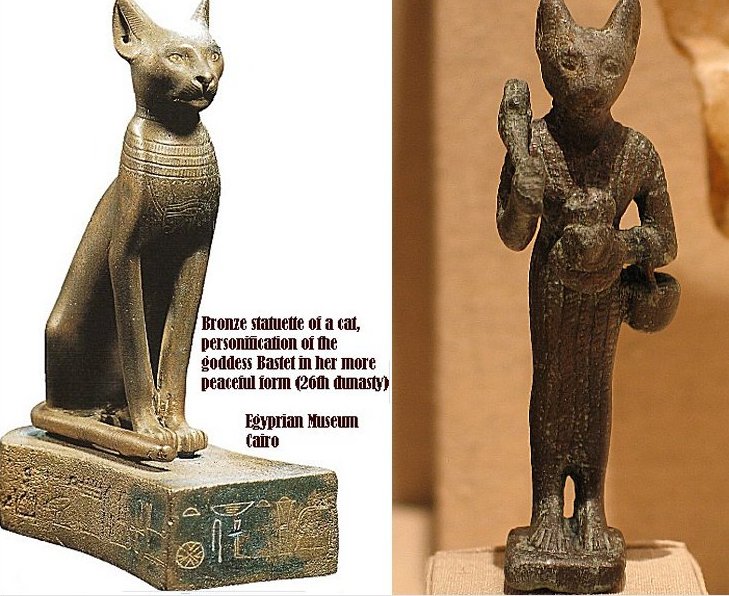 Left: Goddess Bastet; Right: The Goddess Bastet, 305-30 B.C.E. Bronze. Brooklyn Museum
Left: Goddess Bastet; Right: The Goddess Bastet, 305-30 B.C.E. Bronze. Brooklyn Museum
Originally, in earlier beliefs, during the Old Kingdom (c. 2613-2181 BC) when the capital was located in Memphis in Lower Egypt, Bastet was linked with an angry lioness goddess, Sekhmet, destructive and dangerous in nature, and predominantly depicted as a woman with a lion's head. She protected kings when they went to war and was considered a national deity of protection and Pharaoh's guardian goddess.
In the Pyramid Texts, she appeared both in her dangerous form and as a mild-natured mother and nurse of the king, and in the Coffin Texts, her role was to protect the deceased. In later tradition (the end of the second millennium BC), numerous bronze statuettes showed Bastet as a cat-headed, much friendlier deity. Sometimes, she was portrayed holding the rattle-like sistrum instrument.
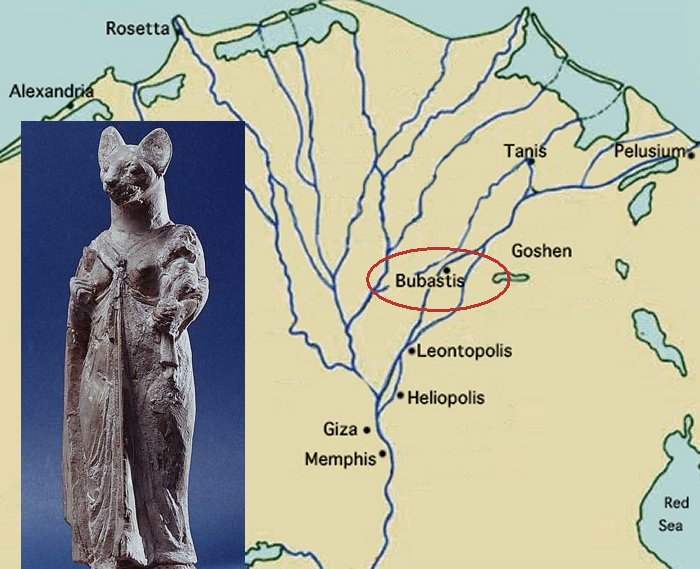 “Bastet’s demonic, terrifying aspect is mainly highlighted in the Coffin Texts and the Book of the Dead and in medical spells. The “slaughterers of Bastet” were said to inflict plague and other disasters on humanity” (G. Pinch). One spell advises pretending to be the “son of Bastet” in order to avoid catching the plague. Bastet may be the poisoned cat who is cured by Ra in a myth alluded to in another healing spell.
“Bastet’s demonic, terrifying aspect is mainly highlighted in the Coffin Texts and the Book of the Dead and in medical spells. The “slaughterers of Bastet” were said to inflict plague and other disasters on humanity” (G. Pinch). One spell advises pretending to be the “son of Bastet” in order to avoid catching the plague. Bastet may be the poisoned cat who is cured by Ra in a myth alluded to in another healing spell.
It seems, however, that both aspects of Bastet’s personality that showed her very dualistic nature (a lioness and a cat) existed simultaneously. She could be aggressive, brave, but also gentle, very soft, and caring.
The 1887 archaeological excavations of the ancient city Bubastis revealed Bastet’s main temple, the catacombs of mummified cats, and several pharaonic shrines that confirmed that even the highest royal personalities worshiped Bastet. A Twelfth Dynasty text, for example, compares an Egyptian king to Sekhmet when he punishes wrongdoers and to the goddess Bastet when he protects his loyal subjects.
Bastet’s temple was impressive, and as Herodotus said in his ' Histories’ Book II: "Other temples are greater and more costly, but none more pleasing to the eye than this..."
Bastet was widely celebrated at various festivals, which included music, dancing, sacrifices, and sistrum-playing. These events took place at the famous cult center, Bubastis located in the eastern Delta. Bastet was believed to be the daughter of the sun god and was often identified with the “Eye of Ra.”
As “the Eye of Ra who protects her father Ra,” she was a manifestation of the solar eye. Bastet was regarded as both the daughter and the consort of Atum-Ra (the sun god). Their son, Mahes (Mihos), was a lion deity.
Left: Ruins of Bubastis, which the Persians destroyed in 350 BC. Right: Wadjet-Bastet, with a lioness head, the solar disk, and the cobra that represents Wadjet. source
Occasionally Bastet was also related to the moon and called the “eye of the moon”.
As one of the most popular and the most feminine and graceful goddesses, Bastet was the personification of the feminine. After all, this goddess was revered as the protector of all women, children, and cats. People could appeal to her with any request.
She was considered to be the mother of the lion god Mahes (Miysis). She occasionally was also the mother of Nefertem, who was originally a lotus flower at the world's creation. In art, she was depicted as a beautiful young man having blue water-lily flowers around his head.
The ancient Greeks compared Bastet to their own goddess Artemis. There is a reference to Bastet in Herodotus writing, saying that women were freed from all constraints during annual festivals at Bubastis. They celebrated the festival of the goddess by drinking, dancing, making music, and displaying their genitals. During the annual festivities, the statue of the goddess was taken out of the temple and transported along the banks of the Nile.
According to Herodotus, these were the most elaborate of all the religious festivals of Egypt.
From an ancient story about Prince Setna (composed in the later first millennium BC), we learn about the erotic reputation of the worshipers of Bastet. Setna encountered Taboubu, the beautiful daughter of a priest of Bastet, and instantly fell in love with her. Taboubu agrees to meet Setna in the house of Bastet in Memphis. Before she sleeps with him, Taboubu makes the infatuated Setna sign a deed giving her all his possessions.
Setna is about to embrace Taboubu when he finds himself alone and naked on the public highway. He even lets her kill his own children and feed their bodies to cats and dogs. It has all been an illusion to punish Setna for stealing a magical book from a tomb.
In this story, the tempting Taboubu may be a manifestation of Bastet herself and her traditional role of punisher of humans who have offended the gods.
Written by – A. Sutherland - AncientPages.com Senior Staff Writer
Updated on September 1, 2021
Copyright © AncientPages.com All rights reserved. This material may not be published, broadcast, rewritten or redistributed in whole or part without the express written permission of AncientPages.com
Expand for referencesReferences:
Hart G. A Dictionary of Egyptian Gods and Goddesses
Redford, D. B. The Oxford Encyclopedia of Ancient Egypt
Pinch G. Handbook of Egyptian Mythology
More From Ancient Pages
-
 Dragon Man: New Species Of Human May Replace Neanderthals As Our Closest Relative
Archaeology | Jun 26, 2021
Dragon Man: New Species Of Human May Replace Neanderthals As Our Closest Relative
Archaeology | Jun 26, 2021 -
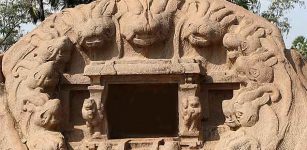 Tiger Cave: Rock-Cut Hindu Temple Complex Dated To East India’s Pallava Empire
Featured Stories | Jan 19, 2017
Tiger Cave: Rock-Cut Hindu Temple Complex Dated To East India’s Pallava Empire
Featured Stories | Jan 19, 2017 -
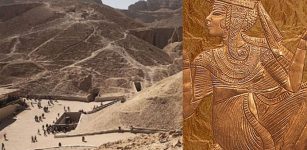 Burial Chamber Of Ankhesenamun, Tutankhamun’s Wife May Soon Be Found
Archaeology | Jan 22, 2018
Burial Chamber Of Ankhesenamun, Tutankhamun’s Wife May Soon Be Found
Archaeology | Jan 22, 2018 -
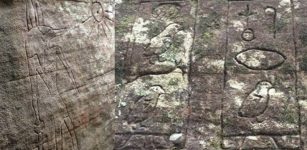 Mysterious Gosford Glyphs: Remarkable Ancient Egyptian Hieroglyphs Discovered In Australia Could Re-Write History
Featured Stories | Feb 20, 2020
Mysterious Gosford Glyphs: Remarkable Ancient Egyptian Hieroglyphs Discovered In Australia Could Re-Write History
Featured Stories | Feb 20, 2020 -
 Unique Temple Of The Condor In Machu Picchu: 3D Spectacular Inca Stonemasonry
Civilizations | Sep 21, 2016
Unique Temple Of The Condor In Machu Picchu: 3D Spectacular Inca Stonemasonry
Civilizations | Sep 21, 2016 -
 African Skeletons From Early Colonial Mexico And First-Generation Slaves
Archaeology | May 4, 2020
African Skeletons From Early Colonial Mexico And First-Generation Slaves
Archaeology | May 4, 2020 -
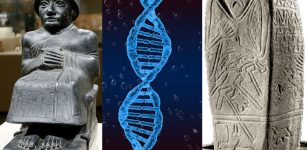 Ancient DNA Provides Comprehensive Genomic History Of The “Cradle Of Civilization”
Archaeology | Oct 10, 2022
Ancient DNA Provides Comprehensive Genomic History Of The “Cradle Of Civilization”
Archaeology | Oct 10, 2022 -
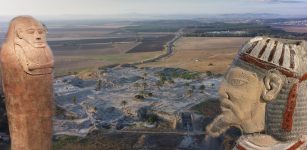 Ancient Mystery Of The Biblical Canaanites – New DNA Insight
Archaeology | May 28, 2020
Ancient Mystery Of The Biblical Canaanites – New DNA Insight
Archaeology | May 28, 2020 -
 Men Are Slowly Losing Their Y Chromosome – Is The Future Of Humanity In Danger?
Featured Stories | Nov 7, 2023
Men Are Slowly Losing Their Y Chromosome – Is The Future Of Humanity In Danger?
Featured Stories | Nov 7, 2023 -
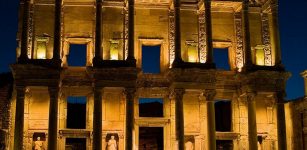 City Of Ephesus And Celsus Library With More Than 12,000 Scrolls
Featured Stories | Sep 17, 2015
City Of Ephesus And Celsus Library With More Than 12,000 Scrolls
Featured Stories | Sep 17, 2015 -
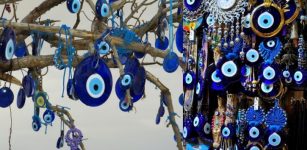 Nazar Amulet – Blue Color Wards Off The Evil Eye According To Ancient Belief
Ancient Symbols | Mar 13, 2018
Nazar Amulet – Blue Color Wards Off The Evil Eye According To Ancient Belief
Ancient Symbols | Mar 13, 2018 -
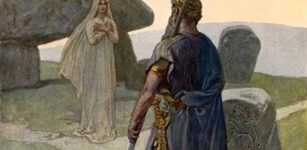 Norse Shamanism: A Völva And Her Prophecies Were Feared Among Norse Gods And Vikings
Featured Stories | May 19, 2020
Norse Shamanism: A Völva And Her Prophecies Were Feared Among Norse Gods And Vikings
Featured Stories | May 19, 2020 -
 Odin: Norse God Of War And Magic – Most Complex Figure Of The Norse Pantheon
Myths & Legends | Oct 27, 2016
Odin: Norse God Of War And Magic – Most Complex Figure Of The Norse Pantheon
Myths & Legends | Oct 27, 2016 -
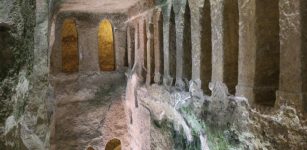 Largest In Europe Underground Church Of Saint-Jean of Aubeterre Built By 12th Century Benedictine Monks
Featured Stories | Feb 12, 2016
Largest In Europe Underground Church Of Saint-Jean of Aubeterre Built By 12th Century Benedictine Monks
Featured Stories | Feb 12, 2016 -
 Spectacular Chand Baori Stepwell Of India That Resembles Reversed Pyramid
Featured Stories | Jul 14, 2015
Spectacular Chand Baori Stepwell Of India That Resembles Reversed Pyramid
Featured Stories | Jul 14, 2015 -
 Impressive Kaymakli Underground City – An Ancient Hiding Place
Featured Stories | Mar 3, 2016
Impressive Kaymakli Underground City – An Ancient Hiding Place
Featured Stories | Mar 3, 2016 -
 Warrior King Eadberht Of Northumbria And A Four-Legged Beast Featured On Ancient Coin Discovered The Holy Island
Archaeology | Nov 11, 2021
Warrior King Eadberht Of Northumbria And A Four-Legged Beast Featured On Ancient Coin Discovered The Holy Island
Archaeology | Nov 11, 2021 -
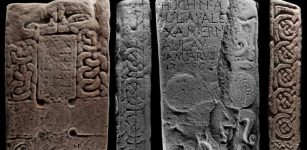 Rare Lost Pictish Stone With Strange Mythical Beasts Goes On Display For The First Time
Artifacts | Dec 12, 2020
Rare Lost Pictish Stone With Strange Mythical Beasts Goes On Display For The First Time
Artifacts | Dec 12, 2020 -
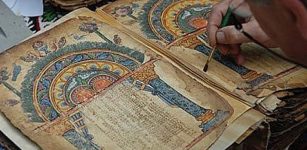 Illuminated Ancient Manuscripts Reflect 1,000 Years Of Human History
Artifacts | Sep 12, 2015
Illuminated Ancient Manuscripts Reflect 1,000 Years Of Human History
Artifacts | Sep 12, 2015 -
 Ancient Tell-Tayinat Inhabitants And Climate Change Resilience – New Study
Archaeology | Oct 30, 2020
Ancient Tell-Tayinat Inhabitants And Climate Change Resilience – New Study
Archaeology | Oct 30, 2020

